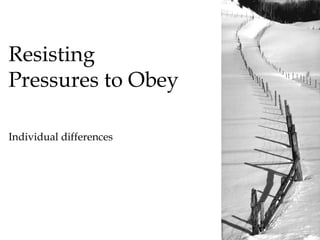
power point on milgram 2
- 1. Resisting Pressures to Obey Individual differences
- 2. Individual differences found by Milgram • As part of his research on obedience, Milgram (1974) noted the background characteristics of those taking part in order to find out which characteristics were consistent with higher or lower obedience. • Age, marital status, occupation and military experience had little influence on the person’s ability to resist the commands of the experimenter. • However, educational history and religious preference did. • Less-educated participants were less likely to resist the experimenter commands than those participants with at least a college degree. • Likewise Roman Catholic participants were more likely to obey the experimenter than were Protestant participants. Free Template from www.brainybetty.com 2
- 3. Insights from Milgram’s studies • In Milgram’s study of obedience, a high proportion of participants gave the maximum 450v, yet others defied the experimenter’s instructions and withdrew before this point. • Milgram found that when the experiment was moved away from the prestigious setting of Yale University to a downtown office, more people felt able to resist authority. This tells us that STATUS is a key factor in obedience/resistance. Free Template from www.brainybetty.com 3
- 4. Insights from Milgram’s studies • Resistance was also increased when the victim could be seen, or when other confederates were present. • This shows us that being made aware of the effects of your actions and having social support are means of increasing resistance. Free Template from www.brainybetty.com 4
- 5. Moral considerations • One of Milgram’s colleagues, moral philosopher Lawrence Kohlberg (1969), presented a group of Milgram’s volunteers with a set of imaginary moral dilemmas. • These dilemmas determined not so much what people would do in situations like Milgram’s shock experiment, but WHY they would behave in that way. Free Template from www.brainybetty.com 5
- 6. Moral considerations • Kohlberg found that • The American civil those who based their rights leader Martin decisions on more Luther King argued general moral that laws are only principles (e.g. the valid insofar as they importance of justice are grounded in over social order), justice, and that a were more defiant in commitment to justice the Milgram study, carries with it an while most of those at obligation to disobey a more restricted level unjust laws. of moral development obeyed the experimenter completely. Free Template from www.brainybetty.com 6
- 7. Martin Luther King and Social Justice Free Template from www.brainybetty.com 7
- 8. Social Heroism • In his book, The • Social heroism Lucifer Effect (2007) involves putting Zimbardo suggests oneself at risk in that while the pursuit of an majority of humanity important principle. is bowing to an unjust • It may be very costly authority, the few in terms of lowered who resist are really social status, loss of heroes. credibility and in • In this context, heroes some cases, even are those people who arrest, torture and are willing to make even death. sacrifices for the good of others in society. Free Template from www.brainybetty.com 8
- 9. Social Heroism• The best-known ‘hero’ is probably Nelson Mandela, imprisoned for 36 years for his resistance to government apartheid policies in South Africa. • A less well-known ‘hero’ is Michael Bernhardt, the US soldier who refused to obey orders to shoot unarmed civilians in the My Lai massacre during the Vietnam war in which nearly 500 Vietnamese died at the hands on the US troops. Free Template from www.brainybetty.com 9
- 10. Michael Bernhardt: Social Hero? • When interviewed by Kohlberg, Bernhardt claimed: • “I can hardly do anything if I know it is wrong. If I think about it long enough, I am just positively compelled.” Free Template from www.brainybetty.com 10
- 11. Zimbardo’s beliefs • Zimbardo believes a key factor that encourages heroic action is stimulation of the ‘heroic imagination’, a mental orientation that makes people more likely to act ‘heroically’ when the time comes. • This involves imagining facing potentially risky social situations, struggling with the hypothetical problems these situations raise, and considering one’s likely actions and their consequences. Free Template from www.brainybetty.com 11